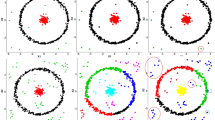Abstract
In this paper, a novel robust maximum entropy clustering algorithm RMEC, as the improved version of the maximum entropy algorithm MEC [2–4], is presented to overcome MEC's drawbacks: very sensitive to outliers and uneasy to label them. Algorithm RMEC incorporates Vapnik's ɛ – insensitive loss function and the new concept of weight factors into its objective function and consequently, its new update rules are derived according to the Lagrangian optimization theory. Compared with algorithm MEC, the main contributions of algorithm RMEC exit in its much better robustness to outliers and the fact that it can effectively label outliers in the dataset using the obtained weight factors. Our experimental results demonstrate its superior performance in enhancing the robustness and labeling outliers in the dataset.
Similar content being viewed by others
References
Rose K, Gurewtiz E, Fox G (1990) A deterministic annealing approach to clustering. Pattern Recogn Lett 11:589–594
Karayiannis NB (1994) MECA: Maximum entropy clustering algorithm. In: Proceedings on IEEE International conference on fuzzy systems, Orlando, pp 630–635
Li RP, Mukaidono M (1995) A maximum entropy approach to fuzzy clustering. In: Proceedings on IEEE International conference fuzzy systems, Yokohama, Japan, pp 2227–2232
Zhang ZH et al (2001) Maximum entropy clustering algorithm and the analysis of its global convergence performance. Science in China (Series E) 31(1):59–70
Las M, Kandel A (1999) Automated perceptions in dataset mining. Proceedings of the Eighth International Conference on Fuzzy System. Seoul, Korea. Part I pp 190–197
Mendenhall W, Reinmuth JE, Beaver RJ (1993) Statistics for management and economics. Duxbury Press, Belmont
Leski JM (2003) Towards a robust clustering. Fuzzy Sets Syst 137(2):191–196
Vapnik V (1998) Statistical learning theory. Wiley, New York
Gill PE, Murray W, Wright MH (1981) Practical optimization. Academic, New York
Huber PJ (1981) Robust statistics. Wiley, New York
Wang Shitong et al (1998) Neuro-fuzzy systems and their applications. The Press of BeiJing Aeronautical University, BeiJing
Steve RG (1998) Support vector machines classification and regression. Technical Report
Deng Zhaohong et al. (2003) Modified min-max fuzzy neural network and function modeling. J Southern Yangtze university, No 3:75–84
Deng Zhaohong, Wang Shitong. Visual kernel perceptron. J Southern Yangtze university
Wang Shitong et al. (2004) Note on the relationship between probabilistic/fuzzy clustering. J Soft Comput 8(7):523–526
Wang Shitong et al. (2004) On fuzzy morphological associative memories. IEEE Trans Fuzzy Syst 12(6):316–323
Wang Shitong et al. (2002) A new integrated clustering algorithm GFC and switching regressions. Int J Pattern Recog Artif Intell 16(4):433–446
Bezdek JC (1982) Pattern recognition with fuzzy objective function algorithms. Plenum, New York
Wang Shitong et al. (2004) Fuzzy kernel clustering with outliers. Chin J Software 15(7):1021–1029
Barnett V, Lewis T (1994) Outliers in statistical data. Wiley, New York
Kollios G, Gunopulos D et al. (2003) Efficient biased sampling for approximate clustering and outlier detection in large data sets. IEEE Trans Knowl Data Eng 15(5):1170–1187
Kailing K, Kriegel HP et al. (2004) Clustering multi-represented objects with noise. In: Proceedings 8th Pacific-Asia Conference on PAKDD'04, Australia, pp 394–403
Jaing MJ, Tseng SS et al. (2001) Two-phase clustering process for outliers detection. Pattern Recog Lett 22(6):691–700
Author information
Authors and Affiliations
Corresponding author
Rights and permissions
About this article
Cite this article
Shitong, W., Chung, K., Zhaohong, D. et al. Robust maximum entropy clustering algorithm with its labeling for outliers. Soft Comput 10, 555–563 (2006). https://doi.org/10.1007/s00500-005-0517-5
Published:
Issue Date:
DOI: https://doi.org/10.1007/s00500-005-0517-5




